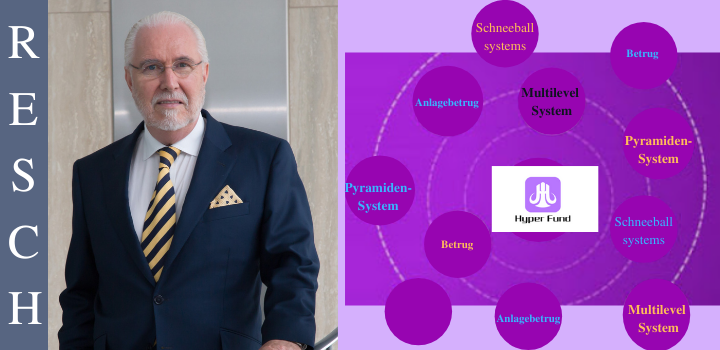HyperFund - Analysis of a Ponzi scheme
The Hyperfund presents itself as a classic pyramid scheme. Obviously, Hyperfund's worldwide success is based on the fact that intermediaries can expect high commissions. It is a multilevel system that rewards each intermediary handsomely. Naturally, the intermediaries at the top of the system make the most money. That's how it is with a pyramid scheme!
HyperFund: Opaque business model
All the more important becomes in the question, where then actually in the business model of the HyperFund the money is earned. What is the business model? That is the central question. And this central question is - typically with a snow ball system - left in the vague.
HyperFund: Gobbledygook about projects with high potential
HyperFund says it is a "DeFi ecosystem for investing in and developing high potential projects." However, HyperFund itself is only one component of the in the organizational structure of HyperTech Group ( hyper.tech, www.hypertechgrp.com ).

Hyperfund: Where is the high potential
On the website www.thehyperfund.com one can find a number of different projects that are presumably part of this "ecosystem". These include DeFi services such as the digital wallet HyperPay, the payment service HyperFin or the company's own bank HyperBC. In addition to these DeFi services, decentralized news services (HyperNews), messengers (HyperTalk) or even video portals (HyperShow) are also listed as projects.
HyperFund: Hardly usable information
While the DeFi projects still have their own websites (hyperbc.com/, hyperfin.com/, hyperpay.tech), information about the other projects is very scarce. Apart from the main page of the HyperTech Group, no really useful information can be found.
Hyperfund: Who is behind it?
The HyperTech Group was allegedly founded by the Australian Zijing Xu, better known as Ryan Xu. Ryan Xu is an entrepreneur and crypto investor who has been active in this field since circa 2014. He is the founder of CollinStar Capital Pty Ltd. (http://www.collinstar.com/about), which was registered with the Australian Companies Registry on Dec. 16, 2014. He is also the founder of Blockchain Global Limited (formerly Bitcoin Group Ltd., https://blockchainglobal.com/about/), which was registered in Australia on Sept. 04, 2014. In addition, according to the Bloomberg article, he is the CTO of Country Heights Holdings BHD, a "real estate conglomerate focused primarily on real estate development and acquisitions" (http://countryheights.com.my/).
HyperFund: How does it all fit together?
Unlike the companies already founded in 2014, there is no entry in the Australian commercial register for HyperTech Group. Nor is it possible to establish any reliable links between Ryan Xu and the HyperTech Group. These are mostly advertising contributions from HyperFund or the HyperTech Group itself.
HyperFund: Everything runs via "The Community
The HyperCommunity is the linchpin when it comes to HyperFund. An online search for HyperFund inevitably lands you on one of dozens, if not hundreds, of "community" sites that invite you to become part of it all. What's notable here is that this is a global sales network. A search on LinkedIn reveals several thousand hits on profiles of alleged HyperFund salespeople from all over the world.
HyperFund: Real money becomes fantasy cryptocurrency
You can become a member of the community by purchasing so-called membership packages, which can currently be purchased at a price of approximately 300, 500 and 1000 USD, whereby these packages can be combined as desired. It should be noted that these packages can probably only be purchased using the cryptocurrency Tether (USDT) and that a "native" currency called HU is obtained with the packages. The packages can be purchased via the specially developed app or a web client. The purchased packages are held for fixed periods of time (usually 600 days) and earn interest at 0.5% daily. Once one has received 50 HU in interest at some point, one can cash it out or "reinvest" it.
HyperFund: How could going public be possible?
If you take a closer look at the entire distribution system and especially the rewards system, you quickly realize that this is a pyramid scheme. There is a big goal of the community, which is worked towards together. This goal is to generate 30 million members, i.e. "investors". This is necessary "in order to be able to carry out a stock exchange IPO worth around $300 billion". In more recent "promotional videos" this value has already been corrected to 45 billion.
HyperFund: Rewards system does not create value
In order to reach this goal there are incentives created by so-called "Rewards" to become active even as Vertriebler and recruit new members. The rewards system is quite complex, however, with a 20-level community rewards system, a 7-level VIP rewards system and a global rewards system. These three systems are hierarchical. The further you climb up the ranks, i.e. the more new customers you attract and the more they invest, the higher "profits" you can achieve. But where and with what money is invested? Where is value created? Rewards cost money, but do not create value, as they are so grandly announced in the business models.
HyperFund: A fraudulent Ponzi scheme?
From the preceding execution it results quite obviously that it might concern HyperFund around snow ball system. Every intermediary - no matter on which level - must notice this. With it the realization is compellingly connected that it might act around a snow ball system and it is thus fraud.
HyperFund: Intermediaries could be liable to prosecution
Every intermediary at every level must be clear about the fact that he could make himself liable to prosecution for fraud or at least for aiding and abetting fraud. In addition, he may have to pay back the money he collected as damages.
HyperFund: Do intermediaries have to compensate for damages?
The obligation to pay damages exists even if the intent of the fraud cannot be proven. Here applies in principle as sufficient, if the mediator acted negligently, thus with a little thinking should have noticed that HyperFund system cannot function in such a way at all and that is obvious is that it I around a snow ball system acts.
First help
Here the free
Initial assessment of your case to the form
Investor protection since 1986 Resch Lawyers
Call us!

Let us help you!
+ 49 30 / 88 59 77 0

